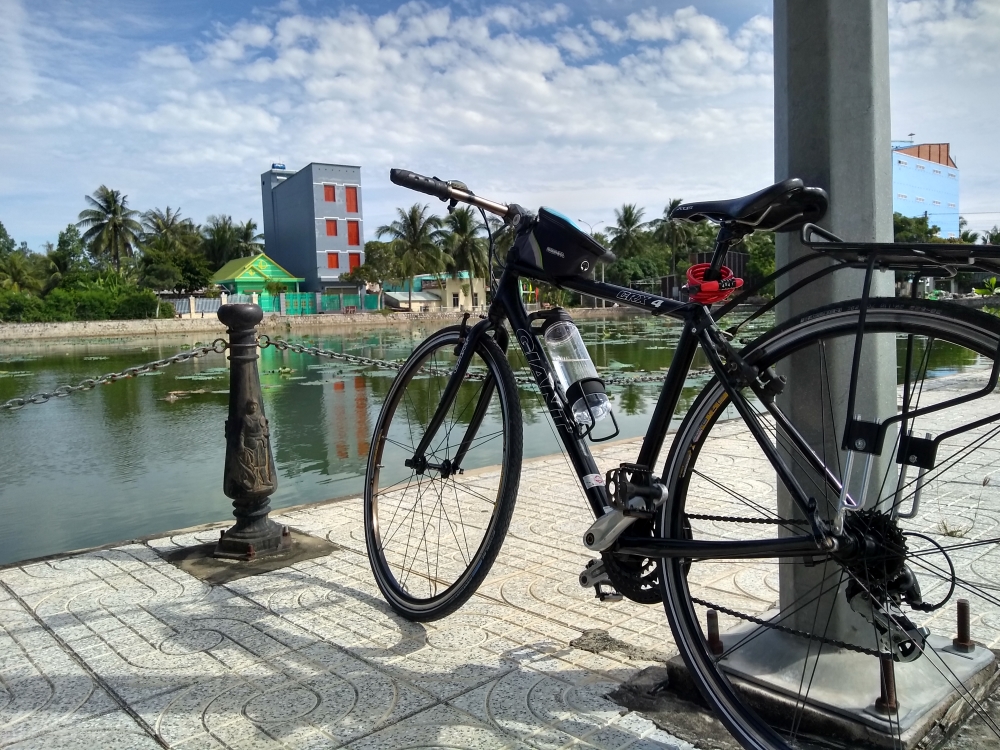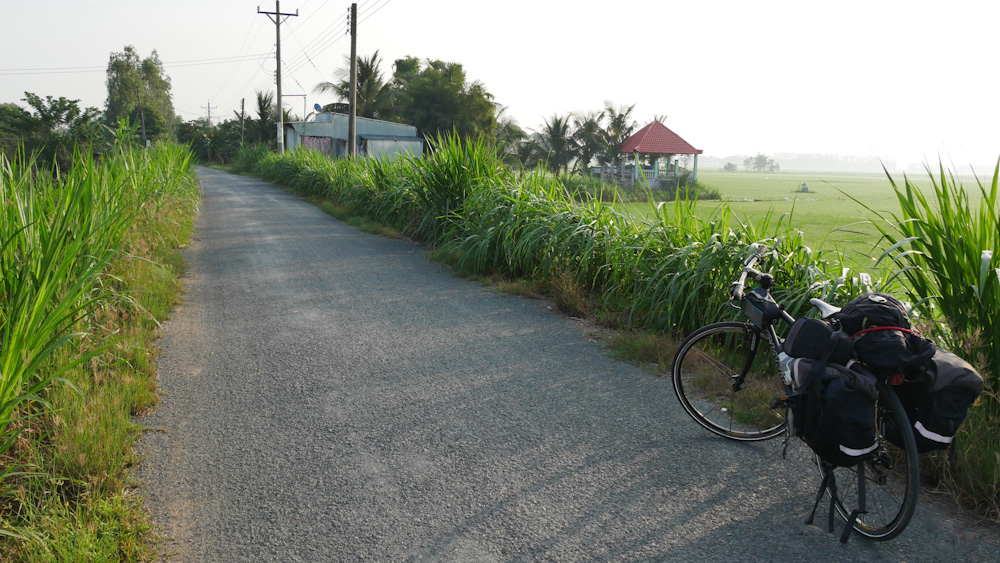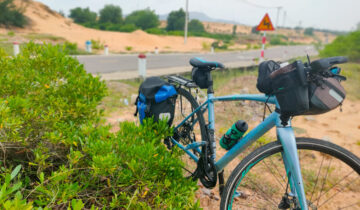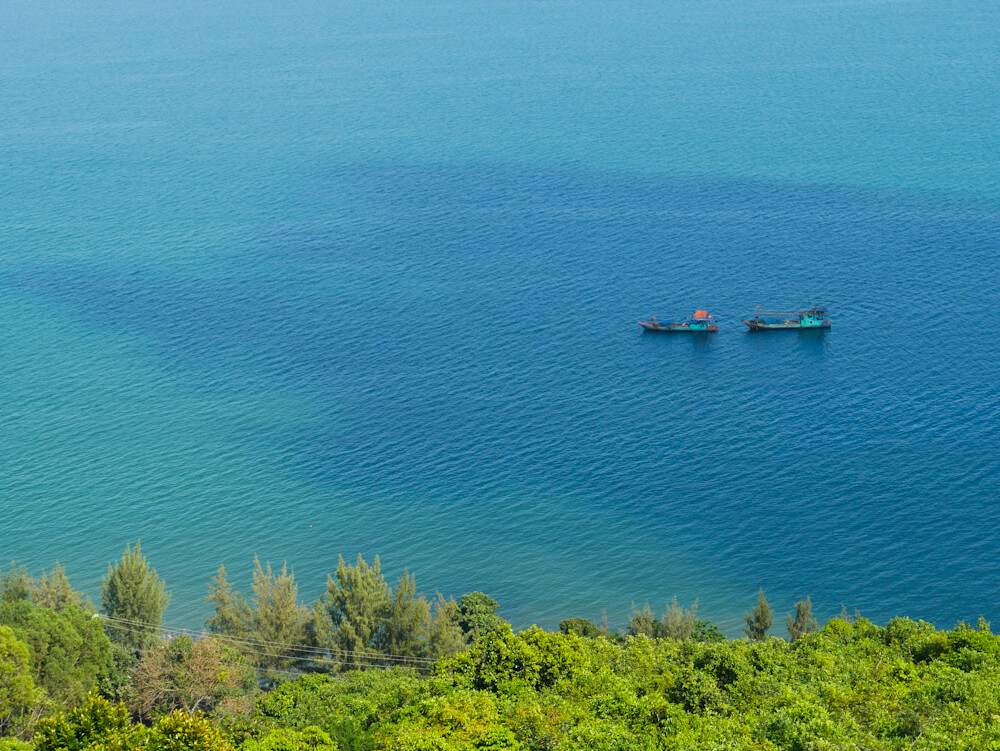Languid, tropical and almost completely flat, Vietnam’s Mekong Delta is fast gaining a reputation as a destination for pushbike travel.
A vast region often described as Vietnam’s food bowl, the delta is criss-crossed by an intricate system of canals, intersected by the mighty Mekong and its tributaries.
What makes cycling so very tempting in this region is the accompanying network of shady paths that wend their way alongside the canals, traversed by wooden barges and interlinked by quaint bridges.
Contents:
How to transport your own bicycle to Vietnam by air.
How to travel on to the Mekong Delta by sleeper bus.
Going it alone, without a tour, will give you unfettered freedom to lose yourself in this tropical world.
That’s because here, more than anywhere in Vietnam, cycling is an end in itself. Rather than landmarks, beaches or ‘must do’ sights, it’s all about the journey.
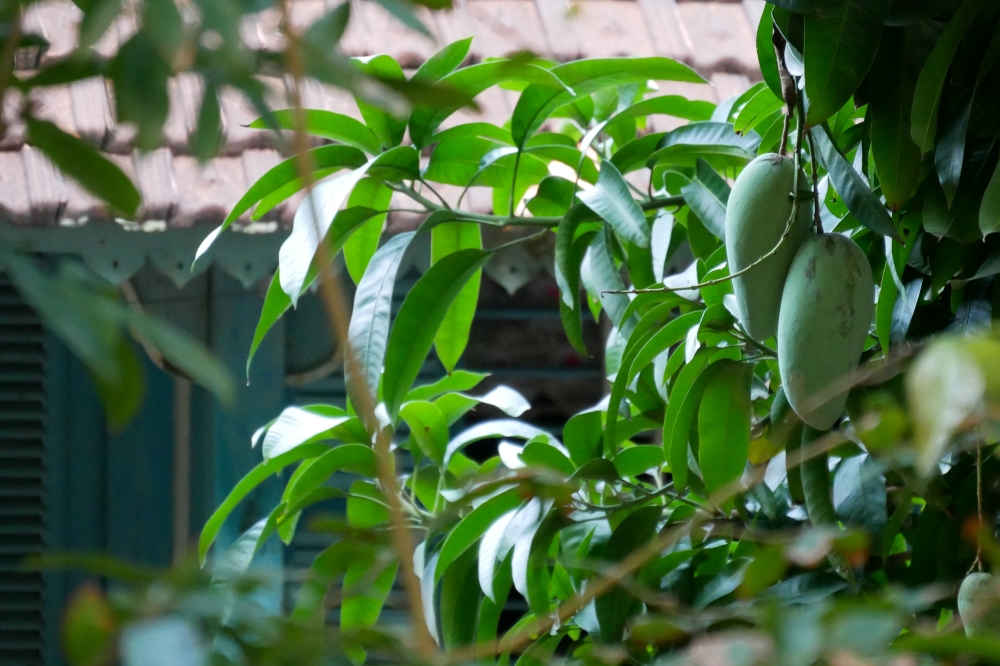
How to get to Vietnam’s Mekong Delta with your own bicycle
This post is based on my experience travelling from Australia to the Mekong Delta. That said the information here should be applicable for just about any destination reachable by bus.
If you are an international visitor thinking of a bike trip in south Vietnam you have three options:
- buy or hire a bike in Ho Chi Minh City then sell or return it
- travel to a regional city and buy one there
- bring your own bike from abroad
For me personally option one was just too much hassle: I didn’t like the idea of shopping for, let alone test-riding a new bike in such a busy, hot and intense place. That said, plenty of people do this and there are heaps of reputable bicycle shops in the southern capital.
Option two was tempting, but left too much to chance. So – option three it was – and as things turned out it was far easier that what I’d thought.
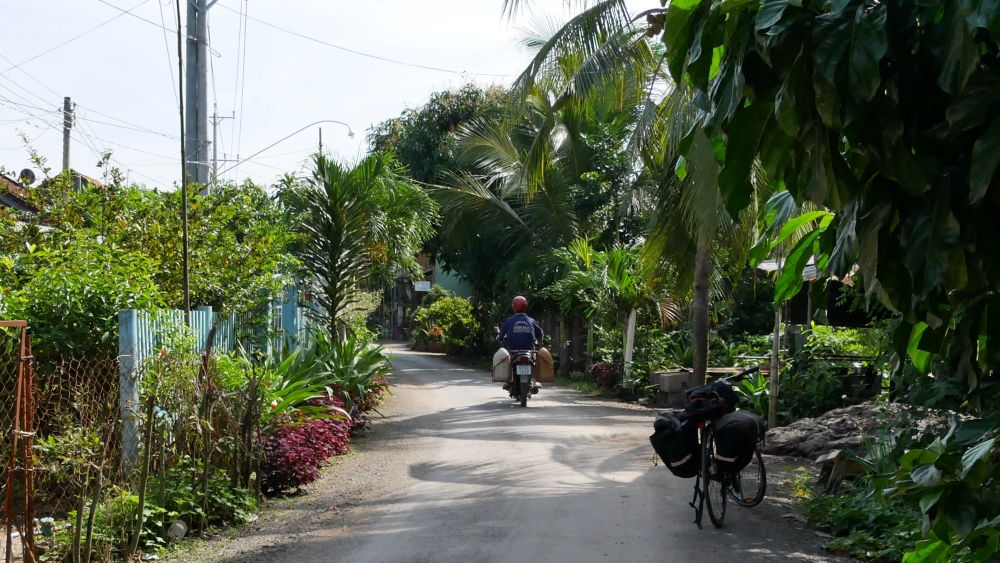
The flight
1. Book in your bike in as oversized baggage
This will vary greatly depending on where you are flying from – different airlines have different policies and systems.
I flew with Jetstar from Melbourne, and their oversized baggage policy for sports equipment is pretty clear and reasonable.
On top of the regular charge for checked baggage, they charge a separate flat fee of $25AUD for handling. So if you paid for 20 kilos of checked luggage, it’s then up to you to make sure your combined luggage (bike plus everything else) weighs no more than 20kg in total.
2. Pack your bike into a cardboard bike box
There is plenty of information out there about how to pack a bike for a plane, and the pros and cons for different methods. I found this post from Travelling Two to be helpful.
A note about boxes versus clear plastic bags: A company called CTC has been selling clear plastic bike bags for some years now, but note they are not permitted on some airlines (including Jetstar).
I used a cardboard box bought from the airport, however it is easy enough to obtain one free from your local bike shop.
Tip: If in doubt, check with your airline via the airport about their requirements for packing/transporting bikes. DO NOT rely on general advice from a centralized airline call centre.
You will need to do three things:
- Remove the pedals. Wrap in bubble wrap and pack them in your checked luggage.
- Unscrew the front bracket of your handlebars so they can be removed from the stem. Pack the bracket and screws in a ziplock bag – and carefully store for re-assembly
- Let some air out of the tires. They don’t need to be deflated all the way; just a little is fine.
- Remove the front tire and pack carefully into the box.
That’s it!
My thoughts on packing your bicycle for air travel
As a novice bike travellers, here’s what I learnt:
- YouTube videos make bike disassembly look WAY easier than it is in real life. Make time to practice and get to know your own bike. Buy plenty of packing tape, duct tape and bubble wrap – more than you think you’ll need.
- Bungee cords are handy for securing any moving parts, such as your back wheel or loose handlebars. They should also be part of your on-the-road kit.
- Pedals can be tricky, especially if your bike is older, or has been out in the rain. By all means try getting them off yourself, but leave enough time to get this done at a bike shop. Sometimes they are just on too tight.
- Getting the handlebars off is easy; putting them back on is less so.
- Use a small piece of tape to mark the position of your handlebars. This will help you to find the correct angle when the time comes to re-attach them.
- An empty one-litre water bottle is ideal for protecting your derailleur. Simply make a vertical cut up one side, slide it over then secure with tape.
- Don’t forget to pack a small pair of scissors in your checked luggage, to cut away tape at your end destination.
Getting from the airport to your hotel
On arrival to Ho Chi Minh City, transport your bike by seven-seater taxi to your hotel. I’d recommend keeping it in its box, making use of the airport trolleys. If you’re a handy type, it’s even possible to kit out your cardboard box with wheels, using a few bits and pieces from your local hardware store.)
While it is slightly further from Saigon’s main sights, I recommend staying in the relatively pleasant and non-touristy area right near the airport. [Read my guide to staying in Saigon’s airport district here].
Grab – Asia’s answer to Uber
A seven-seater taxi will easily fit your bike box in the back and will cost a LOT less if you book via the Grab App, Vietnam’s answer to Uber. Don’t forget to download the app before you go.
Walking out of the front door of the airport can be a daunting experience, especially if you arrive in the middle of the day. The combination of heat, crowds and touts can be overwhelming. Scams are common.
Stay calm, stay focused, and turn left out of the front doors. This will bring you to the taxi rank area.
Taxis line up next to a row of columns marked with numbers 1-14. Head as far to the end as you can: the ideal place to catch a Grab is column 14, close to Burger King.
Buying a SIM card at the airport
To use the app you’ll internet connection which means buying a SIM card at the airport, or using roaming if you have it.
I chose VIETTEL as a mobile phone provider because it offers the best all-round coverage through city and rural areas.
This article from bloggers Too Many Adapters explains the ins and outs of buying a SIM card in Vietnam, and making sure it is registered. But really, all you need to know is that there is an official Viettel booth at the airport – and buying a SIM here will be way easier than anywhere else.
At your hotel
Most hotels will be very flexible when it comes to storing your bike box overnight. I stayed at the Green Ruby Hotel, a typical family mini hotel. and. The staff there had no problem with me using their large back room behind reception on the ground floor.
Getting to the Mekong Delta
The most cost-effective way to get to the Mekong Delta is by long distance sleeper bus. Unless you’ve scored yourself a sweet connecting flight to somewhere like Can Tho or Phu Quoc Island, long distance bus will be your best option: there are no trains south of Saigon.
My independent cycling tour started in Ha Tien, a great little town near Phu Quoc Island and the Cambodian border. I recommend it as a place to acclimatise and get a few ‘out-and-back’ rides under your belt.
Sleeper buses are cheap, frequent, and travel all over the Delta, including to closer towns such as Vinh Long, Sa Dec or Ben Tre.
The following five steps show how I got from Saigon to Ha Tien by sleeper bus.
1. Travel to the Mien Tay Bus Station (Ben Xe Mien Tay).
The confusingly-named Western bus station services all the areas south and west of Saigon, including the Mekong Delta. For travellers, it’s not in a very convenient location – involving a 30 minute drive across town.
All I can say is: do yourself a favour and avoid peak hour.
A comfortable seven-seater Grab taxi cost me around 220K VND (around 8 Euro or $9.50 US).
I really recommend using Grab highly enough – the drivers are professional and it takes the pressure off you to know exactly where you are going and how much it should cost.
Your driver should be able to drop you off outside the correct ticket window if he knows your intended destination within the Mekong Delta.
If you can, ask your hotel receptionist to have a quick chat with the driver in Vietnamese.
2. Buy your ticket at the counter
My ticket to Ha Tien, an eight hour journey, cost 180K with Khai Nam, which was clean, comfortable, friendly and efficient.
FUTA bus, Vietnam’s largest and most reputable company, plies the same route, and also has both day and overnight buses leaving from Mien Tay.
Their booking site is easy to use; and a good option if you are travelling at a busy time (e.g. Friday night) and want to book ahead. Just be aware that only passenger tickets can be booked in this way: large luggage still needs to be booked at the bus station.
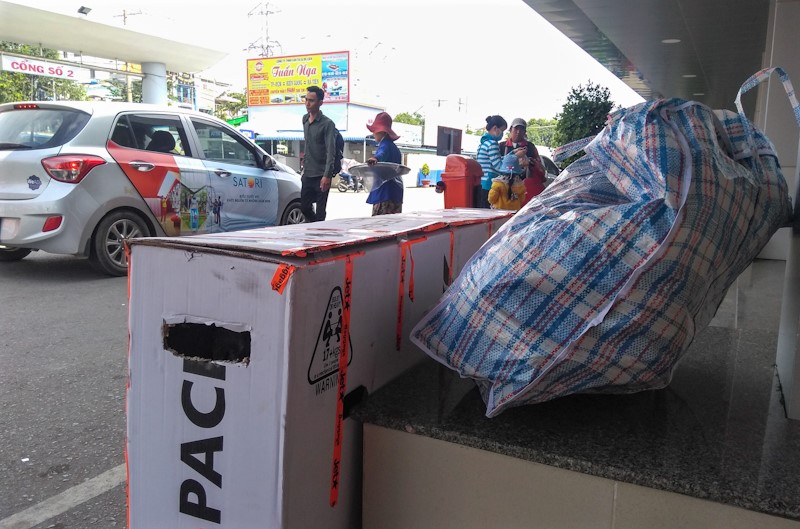
3. Pay the extra luggage fee – this is inclusive of baggage handling at either end.
Expect a bike to cost almost as much as a passenger ticket.
I paid about 120K for my bike ticket. Rest assured that this isn’t a scam; all over Vietnam it is standard for bike tickets to cost almost as much as the passenger.
I’ll admit to being a bit miffed about the fee – until I realised it involved a helper carefully lifting my bike box onto a cart, walking it through the bus station, and onto the bus.
Assembled bicycles are fine travel underneath passenger buses in Vietnam, subject to there being space.
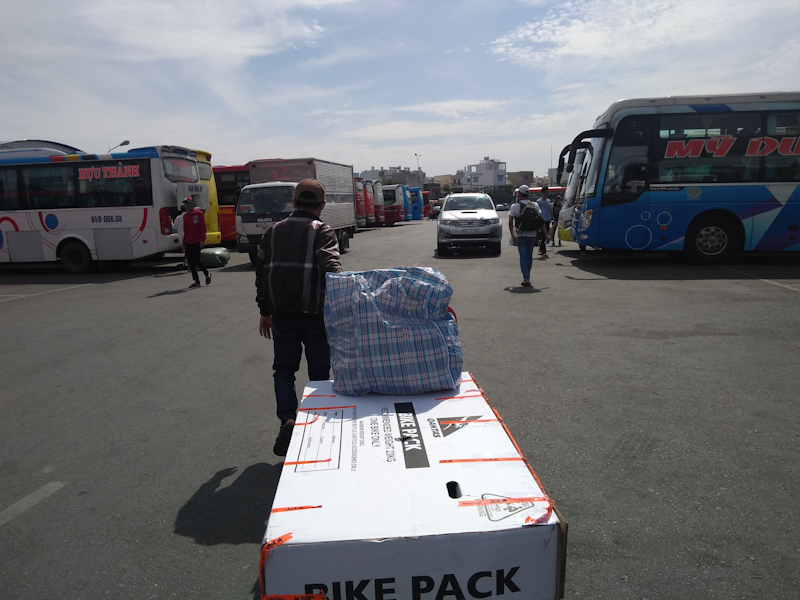

3. Settle back for the journey
The sleeper bus was surprisingly comfortable, with ergonomic berths that let you lie right back.
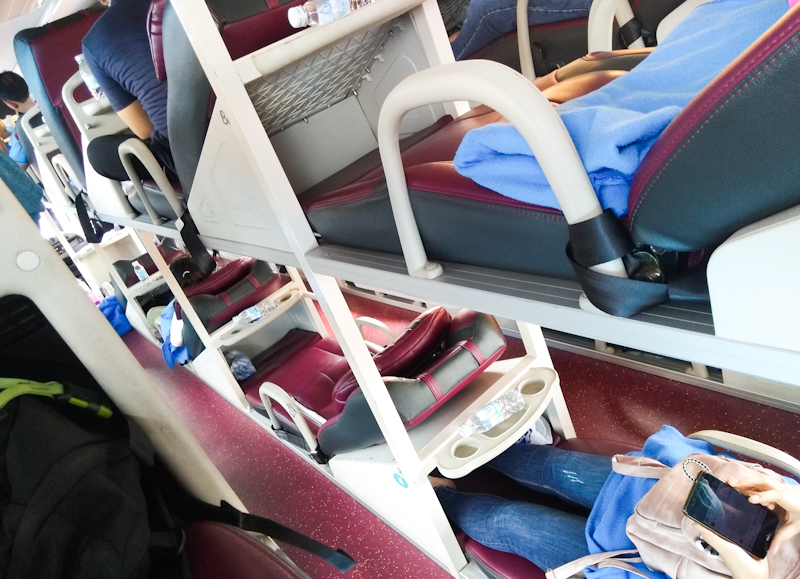
These berths will be not so comfortable if you are tall, unfortunately.
Either way, try to limit the size of the bag you bring with you onto the bus as it will eat up your berth space.
4. Use the free mini bus service to get to your hotel
On reaching your destination you’ll need to assemble your bike and ride to your accommodation,
Alternatively – assuming it is the end of the line – a mini-bus should be on hand to pick up passengers. In my case, a helpful driver transported me and my bike directly to my hotel.
This service is part of your ticket price.
In Ha Tien, the new bus station is a little way out of the centre, so that minibus was a huge relief – especially since I landed in town after dark.
5. Assemble your bike at leisure
Congratulations, you made it! Just a final word of warning – it’s highly likely you’ll be putting your bike together this in front of a crowd of curious locals – if so, welcome to Vietnam!
